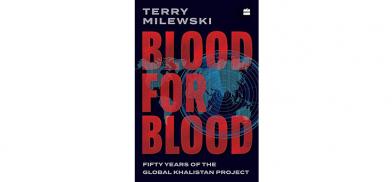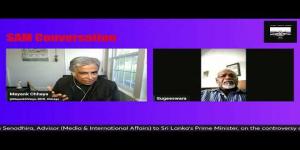A damning expose of how Canada is blatantly condoning Khalistani terrorism
The Khalistanis in the West are thriving even though the Khalistan project is in shambles in Punjab, the state that is home to the Sikhs. Milewski insists that it is the Pakistanis who are driving the campaign – to avenge 1971

Canada’s justice system is blind – and deaf: when the judges are white, when the equally white security agencies are sloppy; when those seeking justice are mostly non-white (even if Canadians); and when the guilty are Khalistani (those part of a separatist movement seeking an independent Sikh homeland called Khalistan), terrorists who go scot-free even for crimes directed at fellow Sikh Canadian citizens. This is the sum and substance of this probing book authored by veteran Canadian journalist Terry Milewski.
Although meant to be a study of the global Khalistani project, Milewski largely focuses on Canada, home to the largest share of the world’s Sikh diaspora at about half a million. Milewski knows the subject and its principal actors in Canada inside out; in a damning expose, he identifies the most active Khalistanis in his country and reveals how the investigation into the 1985 Air India bombing was botched by a biased justice system in Canada.
Khalistani terrorism in Canada
Sikh lawyer and community activist Ujjal Dosanjh, later a premier of British Columbia – the westernmost province of Canada - and a federal health minister, was viciously beaten by a Khalistani in Vancouver. The attacker, Jaspal Atwal of the International Sikh Youth Federation, was freed on a technicality after a novice detective blew up the case. Dosanjh survived only because his law partner appeared at the parking lot.
Atwal later went on to shoot a Punjab cabinet minister Malkiat Singh Sidhu, on Vancouver Island in 1986 (he survived but was assassinated in Punjab five years later); and, shockingly, was with the delegation of Canadian Prime Minister Pierre Trudeau visiting India in 2018 and was photographed with Trudeau’s wife at a reception in Mumbai.
A few months after Dosanjh was attacked, Balraj Deol of the Hindu-Sikh Forum was thrashed in Toronto – the country’s most populous city - by Khalistanis. One of his unpunished attackers, Kulwinder Singh Malhi, went to a Pakistani training camp, crossed over to India and in July 1987 was involved in the killing of 38 Hindu bus passengers near Lalru village in Punjab. Malhi was shot dead by the police in India. No one was punished in Canada for attacking Deol.
Naturally, extremists in Canada went from strength to strength. Even explicit endorsement of political murder did not produce any complaint from Canadian politicians, who were happy to attend rallies called by Khalistanis so as not to erode their Sikh vote bank.
The man who plotted the horrific bombing of the Air India plane off Ireland which killed 331 innocents was Talwinder Singh Parmar, who earlier served a prison sentence in Germany and was wanted in India. The man who assembled the bombs for him was Inderjit Reyat, who confessed. Nothing happened to Parmar in Canada although he was barred from entering the US.
Parmar sneaked into India from Pakistan and was shot dead by the Punjab Police. Khalistanis in Canada eulogized Parmar, the worst mass murderer in Canada’s history. Canadian authorities looked the other way.
Air India bombing
Milewski says Canadian security agencies had plenty of tips about the Air India bombing but did nothing. In August 1984, a French-Canadian criminal, Gerry Boudreault, told the Royal Canadian Mounted Police (RCMP) that some Vancouver Sikhs offered him USD 200,000 to smuggle a bomb onto an Air India flight from Montreal to London.
A Sikh, Harmail Singh Grewal, a petty criminal, told the police separately that some Sikhs planned to use a French-Canadian – it was Boudreault – to blow up an Indian plane. He said the plan involved two bombs and two planes; this is what then happened. The other bomb exploded at the Narita airport in Japan.
On June 1, 1985, three weeks before the bombing, Air India’s security manager in Mumbai sent out a warning that Sikh extremists might blow up an aircraft with explosives. The telex went to the RCMP, which never shared it with the Canadian Security Intelligence Service (CSIS). Two CSIS men tailed Parmar on a trip to Vancouver Island where he went to see how Reyat’s bomb-making was going on. Even then, Parmar was not even questioned.
On June 10, an informer told the police in Toronto that people at gurudwaras were warned not to fly Air India. Nothing happened. And then the Air India plane was bombed. Even after the crime, CSIS refused to reveal its surveillance of the bomb testing episode and no evidence was produced against Parmar.
Judiciary found wanting
Parmar and others were charged in 1986 with conspiring to blow up the Indian Parliament and take hostages. The case was built on wiretaps. The court asked the prosecution to reveal the wiretaps to the defense. The prosecutors refused. Parmar and others walked free.
Almost all criminal cases against the Khalistanis collapsed in Canadian courts. Sikhs who courageously spoke against the terrorists were threatened into silence. The judges simply refused to believe any evidence against the Khalistanis.
When Tara Singh Hayer threatened to expose the bombers, he was shot dead. His friend, Tarsem Purewal, was shot outside his office.
A gangster told the police that Hayer’s was a USD 50,000 contract killing, paid for by the Babbar Khalsa. Ajaib Singh Bari, who gloated that Khalistanis would not rest until 50,000 Hindus were killed and who admitted to be part of the Air India plot, face no punishment in Canada.
The Khalistanis in the West are thriving even though the Khalistan project is in shambles in Punjab, the state that is home to the Sikhs. Milewski insists that it is the Pakistanis who are driving the campaign – to avenge 1971 (the dismemberment of Pakistan with East Pakistan becoming Bangladesh with the help of the Indian government and Indian Army).
The irony is that forced conversions, attacks on gurdwaras and worsening discrimination against religious minorities in Pakistan has left that country now with just 10,000 Sikhs from an earlier two million.
As for the terrorists, their ambitious Khalistan territory encompasses the Indian states of Punjab, Himachal Pradesh, Haryana, Delhi and even parts of Rajasthan – but not an inch of the Punjab which lies in Pakistan! “The separatists clearly know where their patron sets the limits.”
(Blood for Blood: Fifty Years of the Global Khalistan Project; Author Terry Milewski; Publishers HarperCollins India; Pages 251; Price Rs 599)
(The reviewer is a veteran journalist who writes on diplomacy and politics. He can be contacted at ranjini17@hotmail.com)














Post a Comment